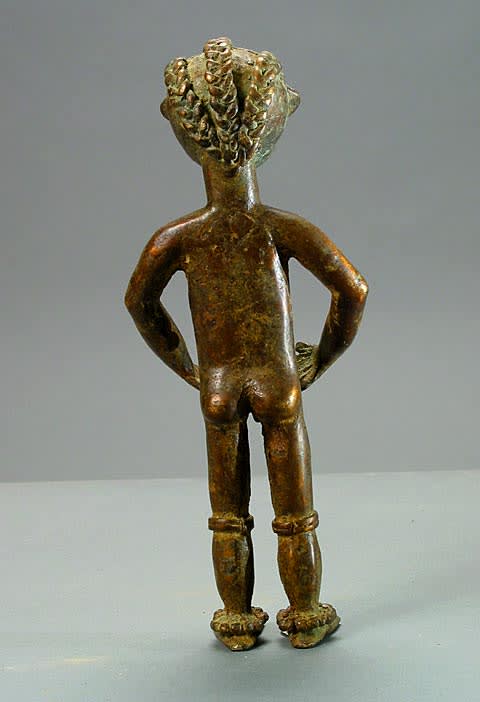Dan Sculpture of a Man, 20th Century CE
Brass
8.5
PF.6065
Further images
Like the gold weights of the Akan peoples and the heddle pulleys of the Baule and Senufo tribes, the bronze figures of the Dan are considered to be the exceptional...
Like the gold weights of the Akan peoples and the heddle pulleys of the Baule and Senufo tribes, the bronze figures of the Dan are considered to be the exceptional case in the corpus of African art: art objects created for art’s sake. Void of any religious significance or ceremonial function, these realistically crafted sculptures were used by chieftains as purely decorative objects. The chieftain took pleasure in them as they are, appreciating the extraordinary beauty of the objects and the inherent skills of the craftsmanship.
This sculpture of a man bears the stylistic signatures of Dan figurative art including the bulbous limbs, planar feet and hands, and the almond-shaped eyes. His head is crowned by an elaborate coiffure featuring three individual braids that fall along the back of his head and merge into one. Such hairstyles imply an elite status when one considers both the other person who must style the hair and the time-consuming labor involved in braiding, time that would otherwise be spent working in the fields. The decorative bands he wears just above his knees and his beaded anklets further imply his wealth and rank in society, as does his sophisticated patterned scarification seen across his chest. Such a splendid masterpiece of sculpture needs no ceremonial or religious purpose to achieve its power. The force of this artwork is the art itself and the hand of the sculptor. Originally, this work was coveted as an object of beauty by chieftains of the Dan tribe. Today, we appreciate this same striking beauty much as the chieftain would have almost a century ago.
This sculpture of a man bears the stylistic signatures of Dan figurative art including the bulbous limbs, planar feet and hands, and the almond-shaped eyes. His head is crowned by an elaborate coiffure featuring three individual braids that fall along the back of his head and merge into one. Such hairstyles imply an elite status when one considers both the other person who must style the hair and the time-consuming labor involved in braiding, time that would otherwise be spent working in the fields. The decorative bands he wears just above his knees and his beaded anklets further imply his wealth and rank in society, as does his sophisticated patterned scarification seen across his chest. Such a splendid masterpiece of sculpture needs no ceremonial or religious purpose to achieve its power. The force of this artwork is the art itself and the hand of the sculptor. Originally, this work was coveted as an object of beauty by chieftains of the Dan tribe. Today, we appreciate this same striking beauty much as the chieftain would have almost a century ago.





